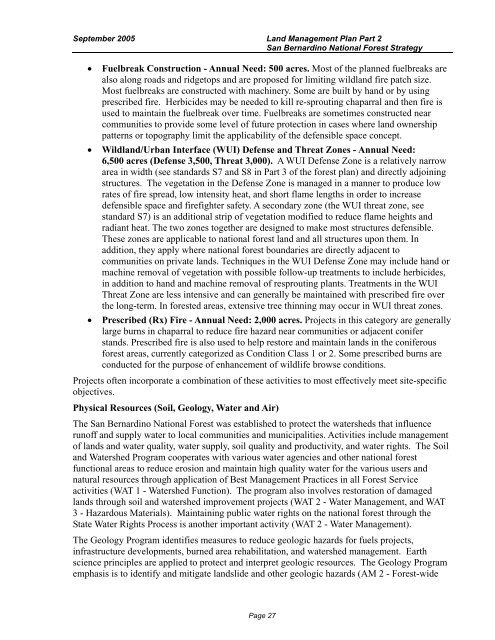San Bernardino National Forest Land Management Plan - Part 2
San Bernardino National Forest Land Management Plan - Part 2
San Bernardino National Forest Land Management Plan - Part 2
Create successful ePaper yourself
Turn your PDF publications into a flip-book with our unique Google optimized e-Paper software.
September 2005 <strong>Land</strong> <strong>Management</strong> <strong>Plan</strong> <strong>Part</strong> 2<br />
<strong>San</strong> <strong>Bernardino</strong> <strong>National</strong> <strong>Forest</strong> Strategy<br />
• Fuelbreak Construction - Annual Need: 500 acres. Most of the planned fuelbreaks are<br />
also along roads and ridgetops and are proposed for limiting wildland fire patch size.<br />
Most fuelbreaks are constructed with machinery. Some are built by hand or by using<br />
prescribed fire. Herbicides may be needed to kill re-sprouting chaparral and then fire is<br />
used to maintain the fuelbreak over time. Fuelbreaks are sometimes constructed near<br />
communities to provide some level of future protection in cases where land ownership<br />
patterns or topography limit the applicability of the defensible space concept.<br />
• Wildland/Urban Interface (WUI) Defense and Threat Zones - Annual Need:<br />
6,500 acres (Defense 3,500, Threat 3,000). A WUI Defense Zone is a relatively narrow<br />
area in width (see standards S7 and S8 in <strong>Part</strong> 3 of the forest plan) and directly adjoining<br />
structures. The vegetation in the Defense Zone is managed in a manner to produce low<br />
rates of fire spread, low intensity heat, and short flame lengths in order to increase<br />
defensible space and firefighter safety. A secondary zone (the WUI threat zone, see<br />
standard S7) is an additional strip of vegetation modified to reduce flame heights and<br />
radiant heat. The two zones together are designed to make most structures defensible.<br />
These zones are applicable to national forest land and all structures upon them. In<br />
addition, they apply where national forest boundaries are directly adjacent to<br />
communities on private lands. Techniques in the WUI Defense Zone may include hand or<br />
machine removal of vegetation with possible follow-up treatments to include herbicides,<br />
in addition to hand and machine removal of resprouting plants. Treatments in the WUI<br />
Threat Zone are less intensive and can generally be maintained with prescribed fire over<br />
the long-term. In forested areas, extensive tree thinning may occur in WUI threat zones.<br />
• Prescribed (Rx) Fire - Annual Need: 2,000 acres. Projects in this category are generally<br />
large burns in chaparral to reduce fire hazard near communities or adjacent conifer<br />
stands. Prescribed fire is also used to help restore and maintain lands in the coniferous<br />
forest areas, currently categorized as Condition Class 1 or 2. Some prescribed burns are<br />
conducted for the purpose of enhancement of wildlife browse conditions.<br />
Projects often incorporate a combination of these activities to most effectively meet site-specific<br />
objectives.<br />
Physical Resources (Soil, Geology, Water and Air)<br />
The <strong>San</strong> <strong>Bernardino</strong> <strong>National</strong> <strong>Forest</strong> was established to protect the watersheds that influence<br />
runoff and supply water to local communities and municipalities. Activities include management<br />
of lands and water quality, water supply, soil quality and productivity, and water rights. The Soil<br />
and Watershed Program cooperates with various water agencies and other national forest<br />
functional areas to reduce erosion and maintain high quality water for the various users and<br />
natural resources through application of Best <strong>Management</strong> Practices in all <strong>Forest</strong> Service<br />
activities (WAT 1 - Watershed Function). The program also involves restoration of damaged<br />
lands through soil and watershed improvement projects (WAT 2 - Water <strong>Management</strong>, and WAT<br />
3 - Hazardous Materials). Maintaining public water rights on the national forest through the<br />
State Water Rights Process is another important activity (WAT 2 - Water <strong>Management</strong>).<br />
The Geology Program identifies measures to reduce geologic hazards for fuels projects,<br />
infrastructure developments, burned area rehabilitation, and watershed management. Earth<br />
science principles are applied to protect and interpret geologic resources. The Geology Program<br />
emphasis is to identify and mitigate landslide and other geologic hazards (AM 2 - <strong>Forest</strong>-wide<br />
Page 27
















